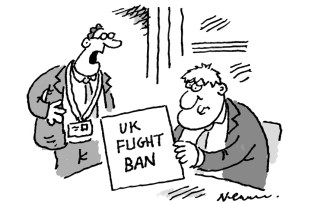Until a few weeks ago, the government’s track record on Covid was one of repeated failure. The death toll, the depth of the recession, the public disapproval of the government: Britain’s figures were among the worst in the world. But with vaccines, things have changed. The UK is now on track to be the first major country in the world to vaccinate its way out of lockdown.
The foreign press coverage has turned from mockery to awe, with Britain having vaccinated more people than France, Germany, Italy and Spain put together. Many of those behind this success are virtually unknown to the public. Their story matters, because the Vaccine Taskforce is already being looked to by ministers as a model for how government should work once the pandemic is over.
Its success starts with a failure: the debacle over PPE. When the virus started, Britain was supposed to unlock the reserves of plastic gloves and gowns prepared for a pandemic by Public Health England. Instead, the fiasco that followed saw the government fleeced by private consultants as countries across the world scrabbled for supply and contracts became meaningless. It was a model of what not to do.
Tensions across government ran high — with Downing Street blaming the Department of Health for the debacle. ‘It was a shitshow,’ said a No. 10 aide reflecting on that period. Sir Patrick Vallance, the chief scientific adviser, concluded that the search for a vaccine would require a new approach — picking a team of outsiders with heft and expertise.
At first, vaccines were seen as a remote possibility — officials pointed out the millions spent in vain on finding a jab for HIV. ‘It was viewed as one of several work-streams,’ says a government aide who was working in No. 10 at the time. ‘The Prime Minister’s main concern was avoiding another lockdown by whatever means available. Which didn’t work.’

Matt Hancock, the Health Secretary, was more optimistic. The example he brought up, however, was the ending of the pandemic film Contagion, where a vaccine is eventually found but there is a scramble to buy it. A reminder, he said, of the need to prepare.
At the time, scientists at Oxford University were working on a vaccine for Mers, an earlier coronavirus. They switched to Covid-19 in early February and looked for a commercial partner: a deal was almost signed with Merck, a US giant, until the small print came up. ‘We needed a cast-iron pledge that they’d supply us exclusively first, but it said “best efforts”,’ says one minister. The fear, then, was that America would ban vaccine exports.
When AstraZeneca came along, the first contract was not good enough — Hancock passed a draft to Downing Street, and Sir Patrick and No. 10 aides spotted a supply problem. It did not give the UK the rights to the vaccine that it now enjoys. They came up with the idea to pay for almost all manufacturing costs in return for secure supply in a British plant. ‘Vallance was hammering the point about onshore manufacturing from early on,’ says an official. ‘He was responsible for that Oxford deal.’
‘Vallance was hammering the point about onshore manufacturing from early on’
Sir Patrick – backed by Dominic Cummings – went to the Prime Minister and said that a vaccine tsar should be appointed so as to avoid repeating old mistakes. The Chancellor agreed – as a former investor with portfolio he believed a hawkish approach on contracts was necessary, even if it carried risk levels that led Treasury officials to describe it as ‘an extremely unusual programme’. ‘They needed someone with immense private expertise — a dealmaker,’ says an aide.
In many ways, Kate Bingham was an obvious choice. An established venture capitalist, she has spent her career investing in pharma companies. But her appointment also led to charges of cronyism: she’s married to Jesse Norman, a Treasury minister, and was at school with Rachel Johnson, the Prime Minister’s sister. ‘Boris picked Kate,’ says one minister. ‘It was his big contribution.’ Given 24 hours to consider, she hesitated on the grounds that she had more expertise in therapeutics than vaccines. But she accepted. The post was unpaid.
Others on the taskforce had already been picked by Sir Patrick — who thought that either vaccines or therapeutics would come off, so it was best to bet big on both. He worried about how little anyone in government knew about vaccines: without importing expertise he feared they were doomed to fail. ‘The briefing notes the civil servants were sending in had basic errors in them,’ says one minister. ‘It was shocking.’ Ian McCubbin, a GlaxoSmithKline veteran, was the first to be hired. He was asked how, if the Oxford vaccine worked, it could be mass-produced.
The Oxford Biomedica plant, where the AZ vaccine is now being made, was identified by the Business department, at the time led by Alok Sharma. ‘We effectively commandeered the manufacturing plant,’ says a minister. The big concern was about the ‘fill and finish’ part of the vaccine process, where drugs are put into a vial. An order was quickly put in for Wockhardt Ltd in Wrexham, which was booked for 18 months. (One of the Prime Minister’s jokes is that it is so-named because they like to work hard.) It is now churning out Oxford vials.
The other mainstay of the Vaccine Taskforce was Nick Elliott, a former army bomb disposal engineer who worked on the railways before specialising in defence procurement. His brief was to ‘make things happen’ — specifically negotiating and delivering contracts. Then came Clive Dix, a Brummie pharmaceuticals chief exec who had known Bingham professionally for years. There were civil servants too. One was Ruth Todd, seconded from the Submarine Delivery Agency. She came up with the idea of submarine codenames for the vaccines, in case any official documents leaked and worldwide competitors would know which vaccines Britain was eyeing. Most members of the taskforce never physically met Bingham, with meetings conducted online.
The UK could not rely on one vaccine coming through. Bingham shortened the 120-odd vaccine candidates to a 23-strong shortlist. Orders were placed for seven vaccines in total, of which three have already been approved, with another three expected. (Sanofi, the French offering, looks like it might fail.) A crunch moment came when Clive Dix chose to prioritise Pfizer over Moderna, whose officials had made headway with the government before Bingham started. The bet was that, for all Moderna’s promise, it would arrive later. So it was to prove: the first orders of Pfizer arrived in December. Moderna is not due until the spring.
There were also tensions over the numbers, with Hancock worried that Bingham only wanted to vaccinate half of the population deemed to be ‘at risk’. He upped the order (which now stands at over 400 million doses for a UK population of 67 million). The plan was always to donate spares to the developing world.
Rolling out the vaccines needed military precision — and the military. Soldiers from 101 Logistic Brigade, under the command of Brigadier Phil Prosser, had been embedded in the NHS since the PPE debacle. ‘They used the same principles of logistics that they did in Afghanistan or Iraq,’ says one official. ‘To them, there is no such thing as “Can’t do it”.’
But there were still several near-misses. One came during the port closures following the French response to the Kent strain of Covid. Lorries were stuck on motorways and among them a delivery of Pfizer vaccines that, once loaded, had to be used within ten days. Ruth Todd didn’t sleep for 36 hours as she came up with contingency plans, including an RAF airlift. ‘We got it from Belgium through France, through the tunnel, into the UK, into our warehouse, in the middle of 3,000 lorries being stuck,’ says one involved.
Once the vaccines were ready to go and be distributed to hospitals and care homes, a plan was needed to ensure that this was done speedily — by bringing in the private sector. As Pfizer’s vaccine needs to be transported at temperatures below freezing, a decision was made not to rely on PHE logistics but to go to companies already used to cold-chain medicine — the distribution arms of Boots and Superdrug. One minister describes it as ‘the best decision we made’.
Though Bingham’s gambles were paying off, she started to become the subject of negative press, with a piece in the Sunday Times saying she had spent £670,000 on PR consultants. Some suspected the briefings were from government departments jealous of her profile. Aides deny it. But when she left the Vaccine Taskforce at the end of December without staying on as an adviser, some thought it a result of her treatment. She has now returned to her investment fund.
The story is not over — and it won’t be a true success story until the vaccines issued are proven to work as advertised. If they do, Covid hospital deaths are projected to be 85 per cent lower than they otherwise would be.
But in terms of how things operated, the Vaccine Taskforce is being seen inside government as exemplary. ‘It makes us ask: is it possible to get things done at this speed and with this competence outside of a pandemic?’ says one minister. An unpublished Treasury report on the process is understood to describe it as a blueprint for an industrial strategy in the future.







Comments